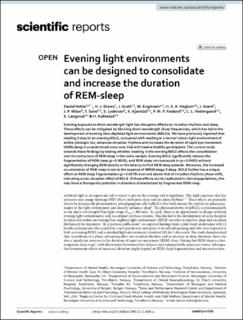| dc.contributor.author | Vethe, Daniel | |
| dc.contributor.author | Drews, Henning Johannes | |
| dc.contributor.author | Scott, Janine Linda | |
| dc.contributor.author | Engstrøm, Morten | |
| dc.contributor.author | Heglum, Hanne Siri Amdahl | |
| dc.contributor.author | Grønli, Janne | |
| dc.contributor.author | Wisor, J.P. | |
| dc.contributor.author | Sand, Trond | |
| dc.contributor.author | Lydersen, Stian | |
| dc.contributor.author | Kjørstad, Kaia | |
| dc.contributor.author | Faaland, Patrick | |
| dc.contributor.author | Vestergaard, Cecilie Lund | |
| dc.contributor.author | Langsrud, Knut | |
| dc.contributor.author | Kallestad, Håvard | |
| dc.date.accessioned | 2023-02-09T13:14:43Z | |
| dc.date.available | 2023-02-09T13:14:43Z | |
| dc.date.created | 2022-08-30T12:29:21Z | |
| dc.date.issued | 2022 | |
| dc.identifier.issn | 2045-2322 | |
| dc.identifier.uri | https://hdl.handle.net/11250/3049757 | |
| dc.description.abstract | Evening exposure to short-wavelength light has disruptive effects on circadian rhythms and sleep. These effects can be mitigated by blocking short-wavelength (blue) frequencies, which has led to the development of evening blue-depleted light environments (BDLEs). We have previously reported that residing 5 days in an evening BDLE, compared with residing in a normal indoor light environment of similar photopic lux, advances circadian rhythms and increases the duration of rapid eye movement (REM) sleep in a randomized cross-over trial with twelve healthy participants. The current study extends these findings by testing whether residing in the evening BDLE affects the consolidation and microstructure of REM sleep in the same sample. Evening BDLE significantly reduces the fragmentation of REM sleep (p = 0.0003), and REM sleep microarousals in (p = 0.0493) without significantly changing REM density or the latency to first REM sleep episode. Moreover, the increased accumulation of REM sleep is not at the expense of NREM stage 3 sleep. BDLE further has a unique effect on REM sleep fragmentation (p = 0.0479) over and above that of circadian rhythms phase-shift, indicating a non-circadian effect of BDLE. If these effects can be replicated in clinical populations, this may have a therapeutic potential in disorders characterized by fragmented REM sleep. | en_US |
| dc.language.iso | eng | en_US |
| dc.publisher | Nature | en_US |
| dc.rights | Navngivelse 4.0 Internasjonal | * |
| dc.rights.uri | http://creativecommons.org/licenses/by/4.0/deed.no | * |
| dc.title | Evening light environments can be designed to consolidate and increase the duration of REM-sleep | en_US |
| dc.type | Journal article | en_US |
| dc.type | Peer reviewed | en_US |
| dc.description.version | publishedVersion | en_US |
| dc.rights.holder | Copyright 2022 The Author(s) | en_US |
| dc.source.articlenumber | 8719 | en_US |
| cristin.ispublished | true | |
| cristin.fulltext | original | |
| cristin.qualitycode | 1 | |
| dc.identifier.doi | 10.1038/s41598-022-12408-w | |
| dc.identifier.cristin | 2047163 | |
| dc.source.journal | Scientific Reports | en_US |
| dc.identifier.citation | Scientific Reports. 2022, 12, 8719. | en_US |
| dc.source.volume | 12 | en_US |
| dc.source.issue | 1 | en_US |

